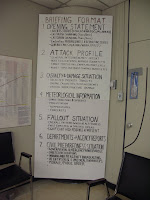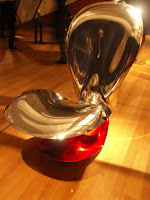
Evidence that Americans have a sense of humour, or that their habit of numbering, rather than naming, roads is sometimes taken too far?
Wednesday 21st Oct.
So to Washington DC, city of grand views and grand statements, both physical and verbal.

Travelled by train from NY to Washington - something of a rattletrap, compared with the Boston to NY train, but still compared moderately well with European trains. The industrial decay and poor housing in north Philadelphia gave way to more attractive views and more prosperous neighbourhoods across the top of Chesapeake Bay, Baltimore and North Washington. Because of the high cost of accommodation in Washington, we (like many people) booked into a hotel in Alexandria, one of several dormitory satellite towns, which are well-connected to the Capital by the subway. Alexandria was established as a port at the same time as Washington was built and was part of the District of Columbia for a while. It was subsequently reclaimed by Virginia and is now a large thriving town with strong provisions for tourists, particularly in the Old Town area, with continuous eateries & shops over about 1 1/2 miles, served by a free tram. There is also an attractive dock area, with an interesting large art gallery/workshop, in which about 200 artists and craftsmen have their studios,from which they sell their work. The complex includes an art school attached and there are also regular live music sessions, though one we attended was of dubious quality. We spent the evening walking through pleasant parks along the edge of the placid Potomac river, in warm weather (24 deg.C).

Not quite The Boat Race - two school crews training on the Potomac near Alexandria on the south bank
We've already made use of nearly all the apparently excessive baggage we brought with us, because of the huge temperature variations we've encountered and the widely differing environments we've been in, from snowy, forested mountaintops to smart(ish) restaurants on warm, sultry evenings.
Since we arrived in the US, we've intermittently had significant problems using UK tri-band phones, for calling locally and to the UK. We must get either a US sim card (not possible in Canada, apparently) or a US phone.
Thursday 22nd Oct.

A member of the paparazzi, with his guide book to aid identification of the building behind him.
Washington's neo-classical monuments and the buildings of the Capitol are even more grand than they appear in pictures. They nearly all record well-known elements of the great statements of the Declaration of Independence, the Constitution or the Bill of Rights, or the utterances of great men (and a very few women) of US history. There are certainly well-preserved vistas on a grand scale, and wide boulevards, which add to the majestic appearance of the Federal Capital. Yet it all seems to be rather overblown and unduly sombre. The picture is somewhat spoiled by the moth-eaten appearance of the mile-long Mall, which should be a splendid sweep of grass, but is worn and churned-up, and the stagnant, dull and murky water of the "Reflecting Pools". The city is noisy with the machinery of transport. Aeroplanes fly low over the city, frequently, into and out of Ronald Reagan Airport, which is the closest of the three airports serving Washington. There are helicopters flying constantly back and forth, presumably ferrying political and business leaders to and from the airport. The avenues are choked with traffic, while the city streets are curiously rather empty of pedestrians. It may be due to the time of year, but we are surprised by the small number of visitors in most of the monuments and museums (with the exception of large school groups in the Lincoln and Jefferson Memorials). The relative lack of advertisements and the discreet (i.e. lack of)signage in the streets surrounding the central area add to a slightly sinister impression of a lifeless, bureaucratic world dominated by machines.
Nevertheless, the lack of queues meant that we were able to see a lot with little difficulty. In the Capitol, we struck lucky with our visit to the visitor's gallery in the Senate, where a number of well-known faces appeared and lingered, including John McCain, Hilary Clinton, Joe Lieberman and Robert Byrd. We saw the closing stages of vote counting on an amendment to a bill. It appeared very informal, with senators drifting into the chamber to register their votes in person with the recorder. She called out the senators' names and their votes, while the senators wandered around, chatting and joking amongst themselves. Then 3 speakers gave warm tributes to a senator who had just become the third longest-serving member of the Senate, having represented Hawaii (as the first Japanese American senator) since that State joined the Union. Business then turned to a discussion re funding for troops for Afghanistan during which senator Robert Byrd (oldest senator at 91) from West Virginia gave a stirring piece of oratory, though to a largely empty House. The visit to the House of Representatives was not so interesting - seemed a more formal approach, with timed speech slots. Later outside, in the grounds of the Capitol, we encountered and watched a press meeting called by a group at of congressmen & women, concerning census procedures.
Apart from a complete lack of signs around the outside of the Capitol, the management of visitors was remarkably efficient, low-key and relaxed, with a very well-staffed system of moving people around the various parts of the building, while maintaining security and enabling the work of the Capitol to go on.

A thing of beauty or kitsch?
In comparison with many of the other buildings, the White House is quite modest in size. We didn't see Barack, but we did see one of a number of very well-photographed people, a sniper on the roof of the President's residence.

The people and government of DC are not altogether enamoured with their second-class status as the home of the federal Government. Their resentment at having only limited representation in Congress is clear for all to see.

Friday 23rd Oct.
Early start to get to the Washington Monument to get tickets for a visit later in the day. Despite the small number of visitors, the limited capacity of the monument means that only about 40 people can visit in each half-hour period, so the daily tickets (free as for all the other federal buildings, museums and monuments)are all distributed by about 9.30 am at this time of the year, and by about 6.30 in mid-summer. Walked (and walked!) around several of the mostly impressive war memorials and monuments. The obvious question that arises, however, is what was achieved by the loss of the tens of thousands of lives recorded in the Korean and Vietnam War Memorials, presumably to be joined eventually by memorials to those killed in Irag and Afghanistan. The US, along with its allies and client states, has a nasty habit of going to war with poor communities around the world, citing grand humanitarian and moral motives of dubious credibility, achieving little other than the deaths of huge numbers of people on all sides. Little or no mention is made of the deaths of either combatents or civilians in the countries being fought over. Despite the constantly repeated moral imperatives of democracy and freedom, which a large proportion of Americans appear to cling to resolutely and openly, there is a notable lack of reference to incursions, or logistical or intelligence support, by the US in countries, in Latin America and elsewhere, to dislodge leaders who have popular support. Curious, too, that the "Patriots" of the Revolution were not "terrorists", as are the patriots in the countries in which the US has intervened.

Washington Monument reflected in the name-listing at the Vietnam War Memorial

A volunteer taking a pencil rubbing of the name of the grandfather of a visitor to the Vietnam War Memorial
We greatly enjoyed a visit to the Hirshhorn Gallery, one part of the huge, eclectic Smithsonian Institute. Pleasing circular building, with a collection of many familar pieces of modern sculpture by Magritte, Matisse, Henry Moore, etc, as well as some of Alexander Calder's mobile sculptures, the forerunners of many a nursery adornment and executive toy.

The weather has turned overcast, so the view from top of the Washington Monument was not optimal, but it nevertheless gave an impressive overview of the city.
Finally visited the Ford Theatre, where Lincoln was shot, and the house across the road, where he died. The associated museum includes the pistol used in the assassination.
Saturday, 24 Oct.
Late start after sorting out problems with a rental car booking, not helped by on-going difficulties with the mobile phones (despite having now acquired a US phone). Spent more time in the excellent Hirshhorn Gallery, then visted the adjacent National Air & Space museum, which was the first place we encontered real crowds. Good exhibits including Apollo 11 capsule, Lyndburg's Spirit of St Louis, and an excellent display about the Wright brothers.

Philip in raincoat and hat, showing deterioration in his physical condition due to lack of food and excessive energy expenditure in walking the vast distances between the sights of Washington
Emerged into very heavy and persistent rain, which made a trip to the Library of Congress a little difficult. The interior decoration of the building is extraordinarily elaborate in the European Renaissance style. Unfortunately the 19th century artists were not in the same league as Michelangelo et al, and the inclusion of numerous overblown epigrams by the great and the good from history adds to the overall kitsch appearance, especially in the Great Hall. There are some more impressive elements, however, including the Reading Room and Jefferson's personal collection of books, which he donated to re-establish the Library after the original collection was incinerated by the British.
We were drenched going back to Metro - the worst weather we've had since starting the trip.
The Washington Metro is much more modern, spacious and altogether more pleasant than the New York Subway. The concrete honeycomb lining in many of the spacious stations is reminiscent of some of the Jubilee Line Stations in London. The lines are designated by colours, which is good in principle but difficult to distinguish in subdued lighting. The fare structure is much more complicated than that on the NY Subway, depending on time and distance of travel, and ticketing arrangements are not as easy as they could be. Many escalators for accessing the stations are open to air and hence to rain and snow. About half of all the escalators in the subways, monuments, museuems, etc, were out of action, under repair. With about a third of all subway ticket gates also not working, there were frequent frustrations and missed trains.



























































